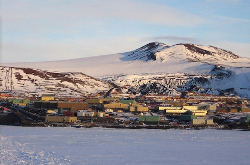남극에서 환자 구하기

In a rare and difficult mission, a plane successfully rescued two sick workers from the U.S. science station at the South Pole Wednesday.
The medical rescue took place in the dark. Regular flights to the South Pole are usually considered too risky between the months of February and October.
The Amundsen-Scott station is run by the National Science Foundation. The plane arrived there after a difficult 2,400-kilometer, nine-hour trip from a British base on the Antarctic Peninsula. NSF spokesman Peter West told VOA the rescue operation went according to plan.
“It was a very challenging operation for the pilots, for everyone who is around to support the pilots, everyone from weather forecasters, to flight followers, all those people. So it was extremely challenging and they have performed exceedingly well in the face of those challenges.”
The National Science Foundation did not release the workers’ names, nationalities, or medical conditions.
The NSF decided last week to evacuate at least one person from the station. The station has a doctor and a physician’s assistant. They make contact with doctors in the U.S. as needed. But, the worker needed medical care that the station’s doctor could not provide. They decided to evacuate a second worker who was also sick.
West said the rescue operation was considered risky because right now Antarctica is always dark and extremely cold.
“It is dark there now, because we are into the Antarctic night. It is very cold at the South Pole. The average temperature is minus 60 Celsius, though it can be colder and can be warmer. There is weather to contend with, which is not the same as temperature. Blowing and drifting snow and all of those things.”
There have been three emergency medical evacuations from the Amundsen-Scott station since 1999.
In 1999, a flight rescued the station's doctor, Jerri Nielsen. She had breast cancer and had been treating herself. She was rescued in the Antarctic spring, when weather conditions are somewhat better. Rescue operations also took place in 2001 and 2003.
Tim Stockings is the operations director at the British Antarctic Survey in London. He told the Associated Press that the latest rescue mission is pushing the limits of what is safe and acceptable.
”Things can change very quickly down there," he said. "The air and Antarctica are unforgiving environments and punishes any slackness very hard.”
Tuesday afternoon’s temperature at the South Pole station was minus 60 degrees Celsius, according to the NSF weather station. The wind chill made it feel like minus 78 degrees Celsius.
West said the extreme cold affects many things on planes. “Most aircraft are not set up to be able to fly in very cold temperatures. The hydraulic systems that move things around like flaps and that sort of thing freeze very easily, get cold very easily. There are issues with fuel and how cold that can be.”
But West called Twin Otter planes used for the rescue mission “very tough aircraft.” He said they are designed to fly in conditions as low as minus 75 degrees Celsius.
A South Pole webcam showed the station in the distance during the landing. West told the Associated Press there was some light because of the full moon.
West called the research taking place at the Amundsen-Scott station “very important science.” Research at the station includes astronomy, physics, and environmental science.
Scientists have been researching gas levels in the atmosphere?including carbon dioxide?for more than 50 years at the South Pole.
Until Wednesday, there were 48 people living and working at the South Pole station. Now there are 46. The National Science Foundation runs two other science stations in Antarctica.

